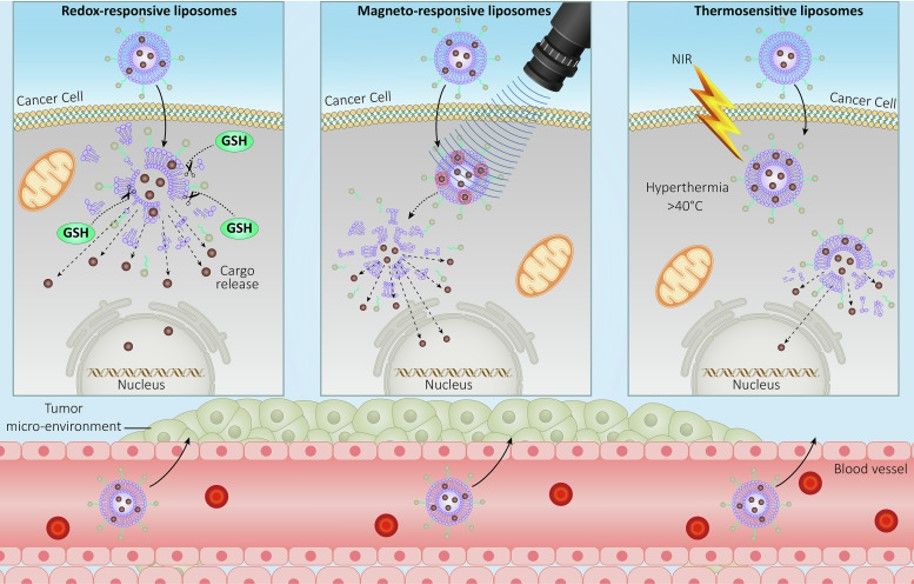Redox-responsive Liposome Development Service
Background Redox-responsive Liposomes Advantages Features
As Creative Biolabs, we pride ourselves on offering the development of redox-responsive liposomes, a state-of-the-art drug delivery technology. By targeting the release of drugs where they're needed most, we can enhance therapeutic effects and minimize side effects, making our redox-responsive liposomes a cutting-edge solution for cancer treatments and beyond.
Background
Glutathione (GSH), is a tripeptide synthesized in the cytoplasm containing a thiol (-SH) group derived from the cysteine residue. As the primary reductant in cells, it exerts its function through the reducing thiol group (-SH). The cellular microenvironment plays a critical role in cell growth and development. Under normal physiological conditions, the concentration of GSH is approximately 0.1 mM, which is essential for maintaining the redox homeostasis required for cellular growth and function. However, in pathological conditions, the cellular microenvironment undergoes changes that lead to an increased involvement of GSH in mediating redox reactions. Elevated concentrations of GSH provide the nutrients necessary for specialized microenvironments. In the bloodstream, the redox balance is continually regulated and maintained by surrounding endothelial cells and the liver, resulting in GSH concentrations that are only about 0.1%-1% of those found intracellularly. In contrast, tumor growth and various genetic alterations require specific environments and nutrients, leading to GSH concentrations in tumor cells that can be up to 100 times higher than in normal cells (100 mM). This significant disparity in GSH concentrations under different pathological conditions highlights its potential as a redox reaction trigger in drug delivery.
What are Redox-responsive Liposomes?
Capitalizing on the distinct redox environments between normal tissues, tumor regions, and the intracellular and extracellular spaces, redox-responsive liposomes can achieve a controlled release of drugs. These redox-responsive liposomes are engineered with redox-sensitive bonds that undergo conformational changes upon reduction by the thiol groups of GSH. Under normal physiological conditions, the structure of redox-responsive liposomes remains intact; however, in pathological states, these liposomes actively or passively target the lesion site, internalized by endocytosis into the targeted cells. Within the cellular microenvironment, the high concentration of GSH triggers the reduction and breaking of the sensitive chemical bonds, leading to the disruption of the liposomal structure and the accelerated release of the encapsulated drug. Common redox-sensitive bonds include disulfide bonds (-S-S-) and diselenide bonds (-Se-Se-), with disulfide bonds being the most widely applied due to their strong redox sensitivity and ease of formation.
|
Redox-sensitive bonds
|
Redox responsiveness
|
Stability in normal conditions
|
Ease of construction
|
|
Disulfide bonds (-S-S-)
|
Strongest
|
Stable
|
Easy
|
|
Diselenide bonds (-Se-Se-)
|
Strong
|
Moderately stable
|
Easy
|
|
Thiol bonds (-S-)
|
Weaker
|
Moderately stable
|
Easier
|
|
Selenol bonds (-Se-)
|
Weakest
|
Least stable
|
Easier
|
 Fig.1 Stimuli-responsive liposomes in cancer drug delivery.1, 2
Fig.1 Stimuli-responsive liposomes in cancer drug delivery.1, 2
Advantages of Redox-responsive Liposomes
-
Enhanced targeting and accumulation: Redox-responsive liposomes leverage the unique redox characteristics of the tumor microenvironment for precise targeting of cancer cells.
-
Reduced systemic toxicity: By achieving precise release at the tumor site, the toxicity of the drug to normal tissues and organs is minimized, thereby reducing adverse reactions.
Our Features in the Development of Redox-responsive Liposomes
-
Advanced technology: Enhanced and targeted drug delivery systems
-
Safety and efficacy: The safety and efficacy of liposomes are our top priorities, underpinned by adherence to the strictest quality standards.
-
R&D expertise: The R&D team at Creative Biolabs boasts a formidable research pedigree and profound industry knowledge
-
Comprehensive development support: From concept to final product, Creative Biolabs provides end-to-end services, including design, development, and scale-up production.
-
After-sales support: Our support continues beyond product delivery, ensuring the most attentive post-sales care for our clients.
Creative Biolabs is proud to offer comprehensive development services for redox-responsive liposomes, please contact us today to discuss your project.
References
-
Ashrafizadeh, Milad, et al. "Stimuli-responsive liposomal nanoformulations in cancer therapy: Pre-clinical & clinical approaches." Journal of controlled release 351 (2022): 50-80.
-
Distributed under Open Access license CC BY 4.0, without modification.

For Research Use Only. Not For Clinical Use

 Fig.1 Stimuli-responsive liposomes in cancer drug delivery.1, 2
Fig.1 Stimuli-responsive liposomes in cancer drug delivery.1, 2
 For Research Use Only. Not For Clinical Use
For Research Use Only. Not For Clinical Use


